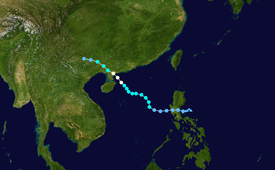Typhoon Chanthu (2010): Difference between revisions
Niceguyedc (talk | contribs) m WPCleaner v1.34 - fix hatnote per WP:INTDABLINK |
No edit summary |
||
| Line 6: | Line 6: | ||
| Year=2010 |
| Year=2010 |
||
| Basin=WPac |
| Basin=WPac |
||
| Image location=Chanthu |
| Image location=Severe Tropical Storm Chanthu at peak strength (07-21-10).jpg |
||
| Image name=Typhoon Chanthu |
| Image name=Typhoon Chanthu as Severe Tropical storm, approaching China |
||
| Formed=July 17, 2010 |
| Formed=July 17, 2010 |
||
| Dissipated=July 23, 2010 |
| Dissipated=July 23, 2010 |
||
Revision as of 22:56, 1 February 2015
| Typhoon (JMA scale) | |
|---|---|
| Category 1 typhoon (SSHWS) | |
 Typhoon Chanthu as Severe Tropical storm, approaching China | |
| Formed | July 17, 2010 |
| Dissipated | July 23, 2010 |
| Highest winds | 10-minute sustained: 130 km/h (80 mph) 1-minute sustained: 150 km/h (90 mph) |
| Lowest pressure | 965 hPa (mbar); 28.5 inHg |
| Fatalities | 13 total |
| Damage | $324 million (2010 USD) |
| Areas affected | Luzon, Guangdong |
| Part of the 2010 Pacific typhoon season | |
Typhoon Chanthu, known as Tropical Storm Caloy, was one of the weaker typhoons of the 2010 Pacific typhoon season.
Meteorological history

Tropical storm (39–73 mph, 63–118 km/h)
Category 1 (74–95 mph, 119–153 km/h)
Category 2 (96–110 mph, 154–177 km/h)
Category 3 (111–129 mph, 178–208 km/h)
Category 4 (130–156 mph, 209–251 km/h)
Category 5 (≥157 mph, ≥252 km/h)
Unknown
Early on July 17, the JMA reported that a tropical depression had developed about 220 km (135 mi) to the northeast of Manila, Philippines.[1] Later that day the JTWC reported that the depression had a small low level circulation center with deep convection flaring to the northeast of the center. However as the low level circulation center was located close to land and was not very organized, the JTWC declared that there was a poor chance of it becoming a significant tropical cyclone within 48 hours. However during that day, the depression rapidly consolidated with an anticyclone helping to develop the low level circulation center. As a result early the next day the JTWC issued a tropical cyclone formation alert on the depression, however they thought that further development might be hindered as it was located close to land. Whilst it moved along the southern edge of the subtropical ridge, the Depression made landfall on Aurora province at 0600 UTC, before the JTWC initiated advisories later that morning, as the low level circulation center had consolidated and poleward outflow into the tropical upper tropospheric trough had improved. Late on July 19, PAGASA issued their last advisory on Tropical Storm Caloy as it had moved out of their Area of Responsibility..[2] Throughout Aurora, heavy rains triggered flash flooding which destroyed at least one home and stranded hundreds of residents. The Paltic barangay, within Dingalan, became inaccessible to rescuers after the local river topped its banks and washed out nearby slopes.[3]Following the system's development, PAGASA stated that rainfall from system could trigger landslides and flooding in Aurora, the Bicol Region, and Quezon.[4]
Impact
Philippines
In Luzon, heavy rains triggered floods that destroyed at least one house and stranded thousands of people.
China
In China, The Xinhua State news reported that two people were killed by walls that were blown over by strong gales. The typhoon made landfall near the city of Wuchuan. State-run television broadcast images of large waves crashing on to the Guangdong shore, trees flattened by wind and electric poles collapsed onto streets under heavy rain.[5] Thereafter heavy flooding swept away a 50-year-old man in a village in Hong Kong.[6] The southern Chinese provinces of Guangdong and Hainan braced themselves, ahead of Typhoon Chanthu's expected landfall. Guangdong meteorological authorities, have launched the highest level of disaster response.[7]
Aftermath
Philippines
Thousands were stranded and the death toll is expected to rise.
China
Like the Philippines, many people were stranded and the death toll is also expected to rise.[8]
References
- ^ "JMA WWJP25 Advisory 2010-07-17 00z". Japan Meteorological Agency. 2010-07-17. Retrieved 2010-07-17.
- ^ Philippine Atmospheric, Geophysical and Astronomical Services Administration (2010-07-17). "Shallow Low Pressure Area Weather Advisory One" (PDF). National Disaster Coordinating Council. Retrieved 2010-07-17.
- ^ "Effects of Active Low Pressure Area in Aurora Province" (PDF). National Disaster Coordinating Council. 2010-07-18.
- ^ 2010 Pacific typhoon season.
- ^ Typhoon Chanthu lashes flood-hit China, July 22, 2010.
- ^ Typhoon Chanthu kills 3 becomes Tropical Storm heading North
- ^ Reporter: Impact of tropical storm Chanthu July 22, 2010
- ^ Reporter: Aftermath of Typhoon Chanthu CCTV News - CNTV English, July 23, 2010
External links
- JMA General Information of Typhoon Chanthu (1003) from Digital Typhoon
- The JMA's Best Track Data on Typhoon Chanthu (1003) Template:Ja
- The JMA's RSMC Best Track Data (Graphics) on Typhoon Chanthu (1003)
- The JMA's RSMC Best Track Data (Text)
- The JTWC's Best Track Data on Typhoon 04W (Chanthu)
- 04W.CHANTHU from the U.S. Naval Research Laboratory

